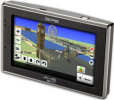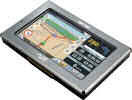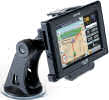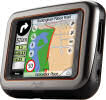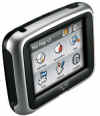Reviews related to : Mio
Mio do several units suitable for pedestrians with an average battery life between charges of four to five hours. This could be used handheld but only for occasional use as the battery life is less than two hours, this is certainly an in car unit.
My first question then is why is it called a DigiWalker? However lets assume there is a reason this seems to me to be a rather good unit. Trying to assume the role of someone who has never had a similar unit could I insert it in my car by using the 13 pages in the getting started guide that are in English, answer yes. Could I plan a simple route answer yes.
Putting away my paper-based maps, it was time to check out another SatNav device.
As part of its range of DigiWalker SatNav devices, Mio has released its C220 model. Although at the more budget end of its product line up, the C220 packs an impressive amount of functionality into a unit that measures 108 x 81 x 24mm (H x W x D) and weighs in at 100g. Opening the box reveals the SatNav device; a three-part connection kit for in-car use; USB lead; software CD; and various items of documentation. The C220 SatNav unit is dominated by the 3.
This is a full featured PDA a phone and of course a GPS unit. However unlike some other PDAs with GPS abilities this is firstly a GPS unit and it has the ability to make phone calls and to be a PDA. Of course being a PDA you only have a soft keyboard.
It is 9.5x6x2cm and weights only less than 150grams. The viewable screen is 5.5x4cm. As a GPS unit it works exactly the same as other recent Mio units reviewed.
Technology can help take some of the strain out of driving by supplying directions through a SatNav device.
Like printers and mobile phones, SatNav devices have started to adopt the mantle of multi-function products. An example of this trend can be seen with the . Along with the main SatNav mapping and directional features, the Mio C520t has audio, image and contact list features plus the ability to link with your mobile phone via Bluetooth connectivity. All this is packed into a device measuring 127 x 81 x 14mm.
Leaving the navigation to others can take some of the strain off driving.
Recently I have noticed a trend with portable peripherals that connect via USB. Instead of providing, as part of the standard package, a power lead to recharge the internal battery via the mains, you have to rely on the USB connection to carry out this function. Maybe this trend can be justified as a cost-cutting exercise but I find it restrictive as I prefer to fully charge such a device in order to check it out before introducing it to my computer.
Having recently looked at the top of the range C520t that seems to do most things. Here is their entry level offering that is exactly what it says a satellite navigation unit.
The unit has one huge plus over it's larger and multifunctional rival, better battery life and should you use it as a cyclist or pedestrian then this is vital. Mio C220 The overall dimensions of the C220 are 10x8x5x2cm and it weights around 150grams. The landscape screen is 7x5.5cm with the largest viewable map area of nearly 5.5cm square when in cockpit mode. Going round the unit the right side has input for an SD card and earbud socket.
This is the top of the range unit from Mio and the size of screen makes it ideal for use in a car. There are modes for pedestrian and bicycle but the size and short battery life make these unsuitable.
Within a few hours of the arriving I had fully charged it and taken it for a drive. To start with without altering any settings it was telling me measurements in metres and finding the switch to change to miles took a while. I noticed with pleasure that there was plenty of volume at the default setting and in fact it had more in reserve. Mio C520t The unit is 12.5x8x2cm and this allows a screen of 10x5.
I saw this unit at the Stuff Live show three months ago, it looked the ideal companion for those who walk around in unfamiliar areas. It can also work efficiently in a car.
It is easily small enough to fit in the hand and I used it regularly for over four hours and even longer with only switching to standby mode on a single charge. It is 8.5x6x2 cm and weights only slightly over 100grams. The base has an earbud socket and mini USB - for charging - as well as a neck/wrist strap anchor point. The left side has 'M' menu button.
As a prime target for break-in merchants, it does help if your Sat Nav device can be placed in your pocket when away from the car. The Mio P350 certainly qualifies.
Sat Nav products tend to fall into one of two main categories. There are devices that have been purposely built to provide just the functionality of satellite navigation whether based in a car or used in pedestrian mode. While a second approach, used by certain companies, involves adding satellite navigation capabilities to a third-party device.
This is a Satellite Navigation unit that specifically mentions a pedestrian mode so a lot of my tests were conducted while walking to various places.
It is 11x8x2cm and weights only around 150grams. If you are going to use it outside a vehicle size and weight are both important. One of my first walks was perhaps my most eventful. It was raining so I of course had the unit well protected in a plastic bag and this meant that I could not use an umbrella. I ended up very wet and due to a glitch rather lost.

